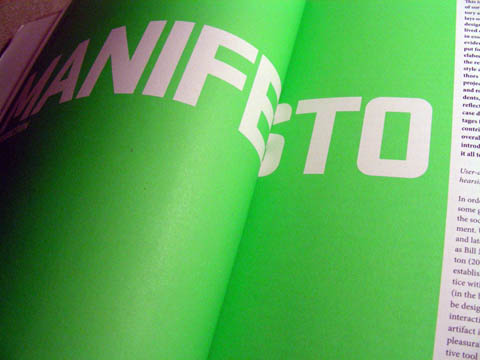February 2011
 Design’s relationship with Art has always been filled with tension. The respect has never felt entirely mutual. But the influence of Art on Design has informed more that the designer’s aesthetic sense, it reminds us to be accountable to the societal aspects of creating artifacts as well. Art has a longer history of influencing society, and Design can learn from that.
Design’s relationship with Art has always been filled with tension. The respect has never felt entirely mutual. But the influence of Art on Design has informed more that the designer’s aesthetic sense, it reminds us to be accountable to the societal aspects of creating artifacts as well. Art has a longer history of influencing society, and Design can learn from that.
Once you remove the artistic sensibilities of creating great work to offer into a cultural experience, the artifact one designs, or the experience on affords through a series of designs, the exercise becomes mechanical, technical.
HCI appears to have a stronger influence on the Interaction Designers in Silicon Valley these days than Design schools. Interaction Designers are more often expected to code, to move straight to software prototypes. Which shifts the focus of their education toward the mechanics of design, rather than the art and theory of design.
I worry when I see designers happy to execute on specs set by others, rather than asking questions about Who, When and Why. HCI, in making the process a technical task, makes the design process internal. HCI designers are armed with rules, structures and standards to apply to interactions. They don’t explore the context of use beyond the human factors, the inputs and outputs, the mechanics, because the right puzzle pieces are in their head to be figured out.
In the book, “Rehearsing the Future” by Halse, Brandt, Clark and Binder, the authors offer an excellent perspective on the similar evolution from user-centered design to participatory design (p. 13) in their manifesto:
The standard principles for what constitutes user-centered design are often not attuned to capturing the most influential aspects of the human experience. As designers are increasingly facing open assignments in complex social arenas where the definition of the problem is not given, but part of the challenge, new guidelines arise that the classical guidelines for good design do not address. […] The answer has less to do with the right order of information than with the socio-cultural situation in which it takes place.
It takes a flexible mind to gather a holistic understanding of complex contexts in order to find complete solutions to the systems problems that design problems look like today.
